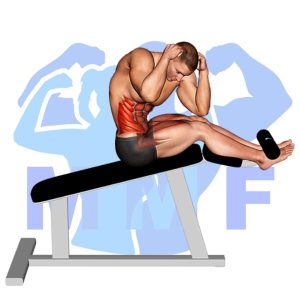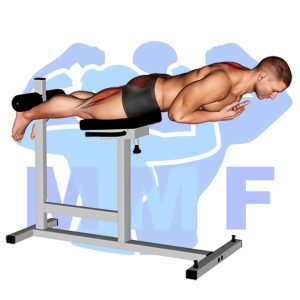Are you tired of feeling defeated by the side bridge hip dip? You’re not alone. Many of us struggle with this common problem area. The unfortunate truth is, our genetics play a big role in where we store fat, and for many of us, it’s the hips and thighs. But fear not, my friends! There is a solution to help lessen the appearance of the side bridge hip dip. In this blog post, we’ll cover exercises and tips to help lean out those stubborn areas and boost your confidence.
Side Bridge Hip Dip Summary
- Primary Muscles: Obliques
- Secondary Muscles: Adductors, Hip, Gluteus Maximus, Gluteus Medius, Gluteus Minimus, Gracilis, Iliocastalis lumborum, Iliocastalis thoracis, Latissimus dorsi, Levator Scapulae, Pectineus, Pectoralis major, Pectoralis minor, Psoas major, Quadratus lumborum, Tensor Fasciae Latae, and Triceps
- Equipment: Body Weight
- Mechanics Type: Isolated
- Force: Pull
- Utility: Auxiliary

Side Bridge Hip Dip Instructions
- Set one forearm on a mat or the ground with your legs out to the side, one leg on top of the other.
- Place your free hand on your upper hip and raise your waist and hip upward by lateral spine flexion.
- Lower your hip down close to the ground without allowing your hip or thigh to touch the ground.
- Raise your hip back to the side bride.
- Continue dipping your hip for ten on one side, then switch sides.
Video Tutorial
Side Bridge Hip Dip Muscles
Target (Agonist)
Synergists
- Adductors
- Hip
- Gluteus Maximus
- Gluteus Medius
- Gluteus Minimus
- Gracilis
- Iliocastalis lumborum
- Iliocastalis thoracis
- Latissimus dorsi
- Levator Scapulae
- Pectineus
- Pectoralis major
- Pectoralis minor
- Psoas major
- Quadratus lumborum
- Tensor Fasciae Latae
- Triceps
Dynamic Stabilizers
- None
Stabilizers
- Iliocastalis lumborum
- Iliocastalis thoracis
Antagonist Stabilizers
- None

Benefits of Side Bridge Hip Dip
The Side Bridge Hip Dip exercise is an effective strength training move that can be used to target the obliques. This exercise works to tone and strengthen the oblique muscles, which are located on the sides of the abdomen. The Side Bridge Hip Dip exercise also helps to improve overall core stability and balance, as it requires the use of multiple muscles throughout the body. Additionally, this exercise can help to increase flexibility in the hips, which can help reduce pain and improve mobility in other areas of the body.
Tips for Performing Side Bridge Hip Dip
Your at the right place if you’re motivated to enhance your side bridge hip dip execution. Using these suggestions will allow you to take full advantage of this amazing workout. In addition to building your obliques muscles, increasing movability, and also a lower possibility of injury can all be achieved with this exercise. Let’s get started and explore how these suggestions will help you.
- Start slow and don’t overexert yourself: start with 10 second holds in each position and slowly increase the duration of the hold as you become more comfortable with the exercise. This will help you to avoid injury while still seeing the benefits of the exercise.
- Activate your core muscles: Make sure to engage your core muscles throughout the exercise to ensure that your form is correct and that you’re reaping all the benefits of the exercise.
- Keep your hips parallel: Make sure to keep your hips parallel to the ground throughout the exercise to ensure that you are getting the full range of motion and targeting all of the muscles in your hips and glutes.
Benefits and Tips Video
Frequent Mistakes To Avoid
Avoiding common errors might be the difference between a successful training session and a painful injury when performing side bridge hip dip. Moreover, achieving the most out of the exercise requires proper form, and avoiding perform common errors can help you to perform the exercise better and obtain optimal results. Don’t worry, though, it’s not at all difficult as it may appear. You can execute the exercise safely and effectively by avoiding the mistakes to prevent and by following the proper steps. Then let’s begin on how to avoid those common mistakes and making this exercise a standard part of your strength training.
- Not engaging the core muscles: This mistake can lead to poor form, decreased benefit from the exercise, and potential injury.
- Allowing the hips to drop too low: This mistake can cause unnecessary strain on the lower back and can lead to discomfort or injury.
- Holding the Side Bridge Hip Dip for too long: Holding the position for too long can cause strain on the muscles and joints and can also lead to fatigue.
Find More Bodyweight Exercises Here
Variations and Complementary Exercises
The Side Bridge Hip Dip exercise is a great way to strengthen your core and glutes, but there are plenty of other exercises that can give you similar results. Here are some variations, complementary, and alternative exercises for the Side Bridge Hip Dip that you can add to your routine.
Side Bridge Hip Abductor

The Side Bridge Hip Abductor is a great complementary or alternative exercise for the Side Bridge Hip Dip. This exercise requires you to be in the side bridge position and then lift your top leg away from your body, while keeping your foot planted on the floor. The Side Bridge Hip Abductor works to strengthen your glutes, abductors, and hip flexors, while also challenging your balance and stability. It is an effective way to target the same muscles as the Side Bridge Hip Dip while also adding an extra challenge.
Horizontal Pallof Press With Bands

The Horizontal Pallof Press With Bands is an excellent complementary or alternative exercise for the Side Bridge Hip Dip. This exercise works the core muscles, including the obliques, in a more dynamic and rotational way. It also places a greater emphasis on stability and balance, which can help to improve overall core strength and stability. The Horizontal Pallof Press With Bands is done by kneeling on one knee and holding the band handles away from your body at chest level. You then press the band outward and away from your body while maintaining a strong core and resisting the force of the band. This exercise is an excellent way to challenge the core muscles in a unique way.
Hanging Oblique Knee Raises

Hanging Oblique Knee Raises are an alternative or complementary exercise to the Side Bridge Hip Dip. It is a great exercise for strengthening the core, lower body, and obliques. This exercise is performed by hanging from a pull-up bar with your feet slightly wider than shoulder-width apart. From this position, you then raise your knees up and out towards your armpits while keeping your back straight. This exercise helps to strengthen the muscles of your core, lower body, and obliques, which helps to improve stability and balance. Additionally, it is an excellent exercise for targeting the area around the hips and abs, which can help to increase mobility and prevent injuries.
Check Out These Top Bodyweight Exercises
Decline Twisting Sit Up

The Decline Twisting Sit Up is an effective complementary or alternative exercise to the Side Bridge Hip Dip. This exercise helps to strengthen the core and improve balance while working the obliques, hips, and lower back. To perform the Decline Twisting Sit Up, start by lying on your back on a decline bench with your knees bent. Place your hands behind your head and then lift your upper body up as you twist from side to side. As you do this, make sure to keep your back flat against the bench and your abs engaged. This exercise is great for targeting the obliques and helping to improve overall core strength and stability.
Cross Oblique Crunch

The Cross Oblique Crunch is an effective exercise to target the obliques, which are the muscles located on the side of the abdominal wall. This exercise can be done with or without weights and is an excellent alternative or complementary exercise to the Side Bridge Hip Dip. It is a simple exercise that involves lying on your back, lifting your knees up towards your chest, and crunching your body across to the opposite side. The Cross Oblique Crunch works both the external and internal obliques for an effective core workout. Not only does this exercise help strengthen and tone the abs, but it also helps to improve balance and stability.
Cable Stability Ball Russian Twists

The Cable Stability Ball Russian Twist is an excellent complementary or alternative exercise to the Side Bridge Hip Dip. It strengthens the core and obliques while improving balance and coordination. To do this exercise, stand on one foot with a cable weight in hand and twist your torso from side to side while keeping your arms extended. This helps to engage the core muscles and challenge the balance and coordination of the body. Additionally, it also helps to improve flexibility and range of motion of the spine. This exercise is great for strengthening the core muscles and improving overall balance and coordination.
Find More Abs Exercises Here
Opposing Complementary Exercises
To further enhance the benefits of Side Bridge Hip Dip, it is important to include exercises that complement this exercise by working the opposing muscle groups. Try these exercises to help you strengthen and tone your core muscles while balancing the body:
45 Degree Hyperextensions

45 Degree Hyperextensions are an exercise that strengthen the lower back muscles and glutes. This exercise works the opposing muscle group to the Side Bridge Hip Dip, which primarily targets the hip abductors. The 45 Degree Hyperextensions involve lying face down on a 45 degree incline bench, with the feet securely hooked underneath the foot pads. The person then raises their torso off the bench until it is parallel with the floor, and then lowers it back down to the starting position. This exercise can be used to build strength in the lower back and glutes, as well as improve core stability and posture. By doing this exercise in conjunction with Side Bridge Hip Dips, a person can ensure that their muscles are balanced and their body is functioning optimally.
Hyperextension

Hyperextension is a great complementary exercise to the Side Bridge Hip Dip. It works the opposing muscle group of the hip dip, which is the lower back. This exercise targets the lower back muscles, helping to strengthen and stabilize them. Hyperextension helps to improve overall postural strength and balance, and it can also help to reduce lower back pain. As an added benefit, performing hyperextensions can help to increase flexibility in the lower back muscles, which can help to reduce the risk of injury. By performing both exercises together, you can build a strong core and back that will help you stay fit and healthy.
Bench Hyperextension

Bench Hyperextension is a great complementary exercise to the Side Bridge Hip Dip. This exercise targets the back muscles, specifically the lower back and glutes, while the Side Bridge Hip Dip works the hip abductors. By performing both exercises together, you can strengthen both the hip and lower back muscles, allowing for greater stability and mobility in the hips. The Bench Hyperextension also helps to improve posture by strengthening the back muscles which are responsible for keeping the spine in alignment. When combined with the Side Bridge Hip Dip, this exercise is an effective way to build strong and healthy hips and lower back muscles.
Transform Your Core With Side Bridge Hip Dips
If you’re looking to transform your core and strengthen your hips, side bridge hip dips are a great exercise option. By engaging your core muscles and using proper form, you can effectively work your obliques and hips. Side bridge hip dips can be modified to accommodate different fitness levels, making it a versatile exercise for beginners and advanced fitness enthusiasts alike. Incorporating this exercise into your regular workout routine can lead to a stronger, toned core and improved overall stability.
References: Wikipedia | ExRx.net | PubMed.gov | Comprehensive List of Abs Bodyweight Exercises




